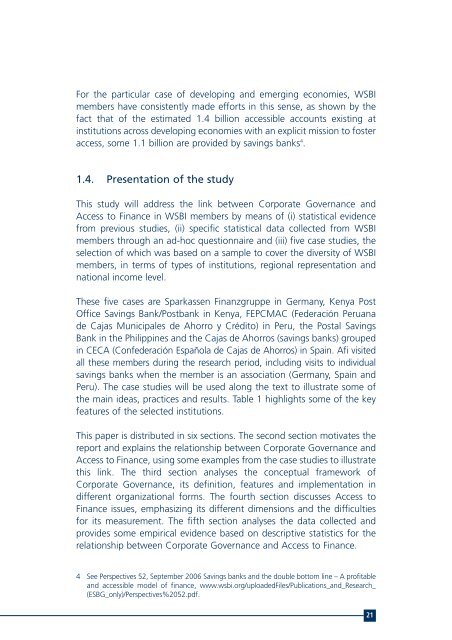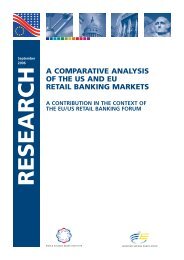Corporate Governance and Access to Finance - ESBG
Corporate Governance and Access to Finance - ESBG
Corporate Governance and Access to Finance - ESBG
Create successful ePaper yourself
Turn your PDF publications into a flip-book with our unique Google optimized e-Paper software.
For the particular case of developing <strong>and</strong> emerging economies, WSBImembers have consistently made efforts in this sense, as shown by thefact that of the estimated 1.4 billion accessible accounts existing atinstitutions across developing economies with an explicit mission <strong>to</strong> fosteraccess, some 1.1 billion are provided by savings banks 4 .1.4. Presentation of the studyThis study will address the link between <strong>Corporate</strong> <strong>Governance</strong> <strong>and</strong><strong>Access</strong> <strong>to</strong> <strong>Finance</strong> in WSBI members by means of (i) statistical evidencefrom previous studies, (ii) specific statistical data collected from WSBImembers through an ad-hoc questionnaire <strong>and</strong> (iii) five case studies, theselection of which was based on a sample <strong>to</strong> cover the diversity of WSBImembers, in terms of types of institutions, regional representation <strong>and</strong>national income level.These five cases are Sparkassen Finanzgruppe in Germany, Kenya PostOffice Savings Bank/Postbank in Kenya, FEPCMAC (Federación Peruanade Cajas Municipales de Ahorro y Crédi<strong>to</strong>) in Peru, the Postal SavingsBank in the Philippines <strong>and</strong> the Cajas de Ahorros (savings banks) groupedin CECA (Confederación Española de Cajas de Ahorros) in Spain. Afi visitedall these members during the research period, including visits <strong>to</strong> individualsavings banks when the member is an association (Germany, Spain <strong>and</strong>Peru). The case studies will be used along the text <strong>to</strong> illustrate some ofthe main ideas, practices <strong>and</strong> results. Table 1 highlights some of the keyfeatures of the selected institutions.This paper is distributed in six sections. The second section motivates thereport <strong>and</strong> explains the relationship between <strong>Corporate</strong> <strong>Governance</strong> <strong>and</strong><strong>Access</strong> <strong>to</strong> <strong>Finance</strong>, using some examples from the case studies <strong>to</strong> illustratethis link. The third section analyses the conceptual framework of<strong>Corporate</strong> <strong>Governance</strong>, its definition, features <strong>and</strong> implementation indifferent organizational forms. The fourth section discusses <strong>Access</strong> <strong>to</strong><strong>Finance</strong> issues, emphasizing its different dimensions <strong>and</strong> the difficultiesfor its measurement. The fifth section analyses the data collected <strong>and</strong>provides some empirical evidence based on descriptive statistics for therelationship between <strong>Corporate</strong> <strong>Governance</strong> <strong>and</strong> <strong>Access</strong> <strong>to</strong> <strong>Finance</strong>.4 See Perspectives 52, September 2006 Savings banks <strong>and</strong> the double bot<strong>to</strong>m line – A profitable<strong>and</strong> accessible model of finance, www.wsbi.org/uploadedFiles/Publications_<strong>and</strong>_Research_(<strong>ESBG</strong>_only)/Perspectives%2052.pdf.21
















